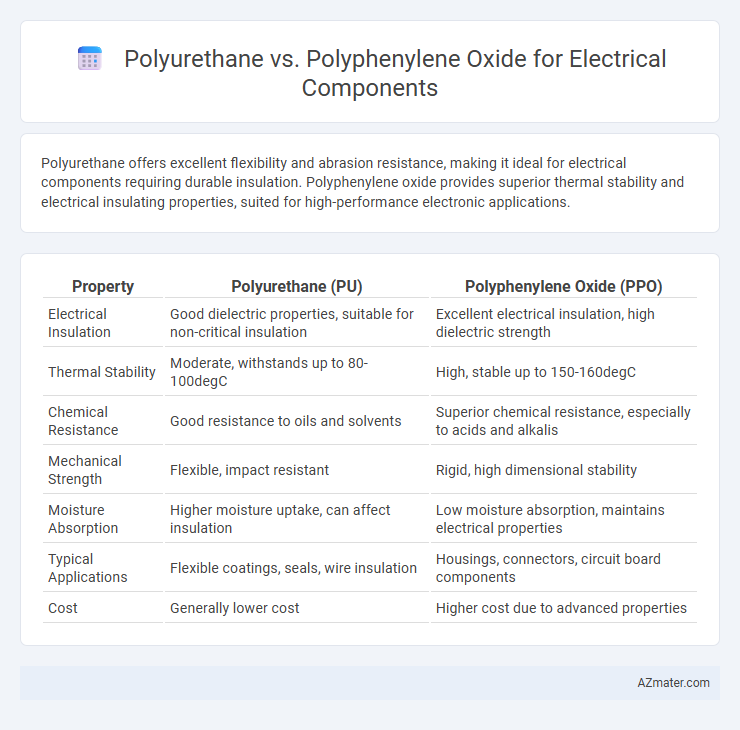Polyurethane offers excellent flexibility and abrasion resistance, making it ideal for electrical components requiring durable insulation. Polyphenylene oxide provides superior thermal stability and electrical insulating properties, suited for high-performance electronic applications.
Table of Comparison
| Property | Polyurethane (PU) | Polyphenylene Oxide (PPO) |
|---|---|---|
| Electrical Insulation | Good dielectric properties, suitable for non-critical insulation | Excellent electrical insulation, high dielectric strength |
| Thermal Stability | Moderate, withstands up to 80-100degC | High, stable up to 150-160degC |
| Chemical Resistance | Good resistance to oils and solvents | Superior chemical resistance, especially to acids and alkalis |
| Mechanical Strength | Flexible, impact resistant | Rigid, high dimensional stability |
| Moisture Absorption | Higher moisture uptake, can affect insulation | Low moisture absorption, maintains electrical properties |
| Typical Applications | Flexible coatings, seals, wire insulation | Housings, connectors, circuit board components |
| Cost | Generally lower cost | Higher cost due to advanced properties |
Introduction to Electrical Component Materials
Polyurethane offers excellent flexibility, chemical resistance, and electrical insulation properties, making it a preferred choice for encapsulating and protecting delicate electrical components. Polyphenylene oxide (PPO), known for its high thermal stability, dimensional stability, and dielectric strength, is ideal for applications requiring performance under elevated temperatures and mechanical stress. Both materials play critical roles in enhancing the durability and reliability of electrical components, with polyurethane excelling in shock absorption and PPO excelling in maintaining electrical integrity under harsh conditions.
Overview of Polyurethane (PU)
Polyurethane (PU) is a versatile polymer known for its excellent electrical insulation properties, mechanical flexibility, and resistance to abrasion, making it ideal for electrical components such as wire coatings and connectors. Its chemical structure allows for high dielectric strength and durability under thermal stress, outperforming many alternatives in maintaining stable performance. PU's resistance to moisture and solvents ensures longevity and reliability in demanding electrical environments.
Overview of Polyphenylene Oxide (PPO)
Polyphenylene oxide (PPO) is a high-performance thermoplastic widely used in electrical components due to its excellent electrical insulation properties, thermal stability, and dimensional stability. It offers superior resistance to moisture, chemicals, and heat compared to polyurethane, making it ideal for applications requiring long-term reliability in harsh environments. PPO's inherent flame retardancy and low dielectric constant enhance safety and signal integrity in electronic devices.
Electrical Insulation Properties: PU vs PPO
Polyurethane (PU) exhibits excellent electrical insulation properties characterized by high dielectric strength and low dielectric loss, making it suitable for flexible electrical components and protective coatings. Polyphenylene oxide (PPO) offers superior thermal stability and consistently high electrical resistivity, which enhances its performance in high-temperature electrical insulation applications. Comparing both, PU provides better flexibility and impact resistance, while PPO ensures long-term reliability under thermal stress due to its robust insulating characteristics.
Thermal Stability and Heat Resistance
Polyphenylene oxide (PPO) exhibits superior thermal stability and heat resistance compared to polyurethane, making it more suitable for electrical components exposed to high temperatures. PPO maintains structural integrity and electrical insulation properties at continuous operating temperatures up to 150-180degC, whereas polyurethane typically degrades above 100-120degC. The high glass transition temperature and low thermal conductivity of PPO contribute to its enhanced performance in thermal management within electrical applications.
Mechanical Strength and Durability
Polyurethane exhibits superior mechanical strength due to its high elasticity and impact resistance, making it ideal for electrical components subjected to physical stress. Polyphenylene oxide offers excellent dimensional stability and thermal resistance, enhancing durability in high-temperature electrical applications. Both materials provide robust performance, but polyurethane is preferred for flexibility, while polyphenylene oxide excels in maintaining structural integrity over prolonged heat exposure.
Chemical Resistance Comparison
Polyurethane exhibits excellent chemical resistance against oils, solvents, and greases, making it suitable for electrical components exposed to harsh environments. Polyphenylene oxide (PPO) offers superior resistance to hydrocarbon-based chemicals and maintains dimensional stability under chemical stress. While polyurethane provides flexibility and impact resistance, PPO delivers enhanced thermal stability and robustness against organic solvents critical for long-term electrical applications.
Ease of Manufacturing and Processing
Polyurethane offers superior flexibility and ease of molding, enabling efficient injection molding and casting processes for electrical components. Polyphenylene oxide (PPO) provides excellent thermal stability but requires higher processing temperatures and specialized equipment, making manufacturing more complex. Overall, polyurethane's adaptable processing conditions result in faster production cycles and lower tooling costs compared to the more rigid and temperature-sensitive PPO.
Typical Applications in Electrical Components
Polyurethane is commonly utilized in electrical components for insulation coatings, flexible protective layers, and encapsulation due to its excellent dielectric properties and mechanical flexibility. Polyphenylene oxide (PPO) is preferred for connector housings, switches, and circuit breakers because of its high thermal stability, dimensional stability, and resistance to electrical tracking. Both materials enhance electrical performance, with polyurethane offering superior flexibility and PPO providing robust structural integrity in critical electrical applications.
Cost Analysis and Material Selection
Polyurethane offers cost-effective flexibility and excellent abrasion resistance, making it ideal for electrical components requiring durability and insulation at a lower price point. Polyphenylene oxide, while more expensive, provides superior thermal stability, electrical insulation properties, and dimensional stability, justifying its selection for high-performance and high-temperature applications. Evaluating total lifecycle costs, including maintenance and failure rates, is critical when selecting between polyurethane and polyphenylene oxide for electrical components.

Infographic: Polyurethane vs Polyphenylene oxide for Electrical component
 azmater.com
azmater.com